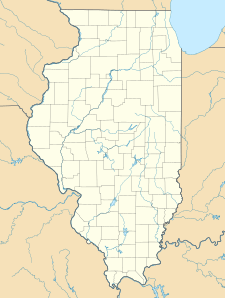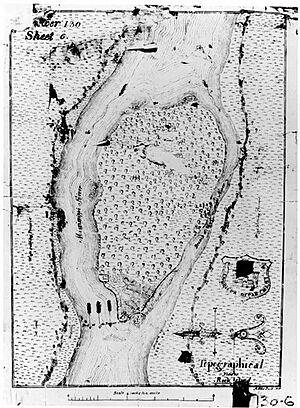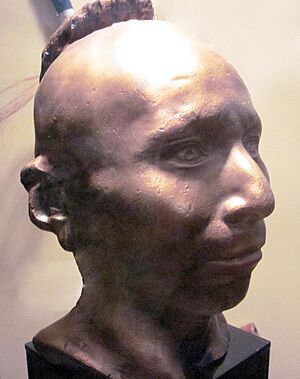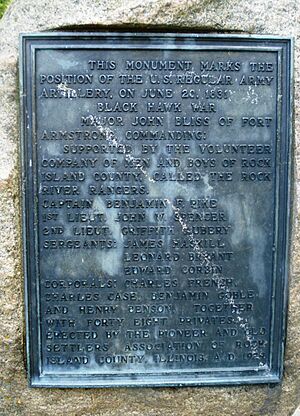Black Hawk State Historic Site facts for kids
Quick facts for kids Black Hawk State Historic Site |
|
|---|---|
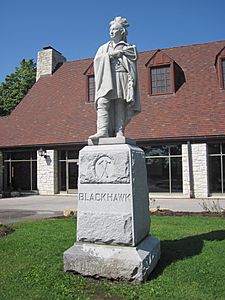
Statue of Black Hawk, Black Hawk State Historic Site, by Welsh sculptor David Richards.
|
|
| Location | Rock Island, Illinois |
| Owner | Illinois Historic Preservation Division |
The Black Hawk State Historic Site in Rock Island, Illinois, is a special place. It sits next to where the village of Saukenuk once stood. This village was home to a group of Sauk Native Americans. Today, the site also has the John Hauberg Museum of Native American Life.
This state park is on a 150-foot (46 m) bluff. It looks over the Rock River in western Illinois. The site is famous as the birthplace of the Sauk warrior Black Hawk. A disagreement over who owned this land led to the Black Hawk War.
Contents
Exploring the History of Black Hawk State Historic Site
Life in Saukenuk: The Sauk Village History
The Sauk nation lived in this area for a long time. Their main village was called "Saukenuk." It was a great spot for growing corn because the land drained well. The Sauk likely arrived here around 1750, after some conflicts called the Fox Wars.
When explorer Jonathan Carver visited in 1766, he was very impressed. He called Saukenuk "the largest and best built Indian town" he had ever seen. He thought it looked more like a modern town than a wild settlement.
The Sauk people farmed in the village during part of the year. In winter, they moved to camps along the Mississippi River. There, they hunted animals for their fur. They sold these furs to traders from the Great Lakes. Many of these traders were British.
In the spring, the Sauk would gather in sugar camps. They made maple sugar before returning to Saukenuk. They would plant their crops and bury their loved ones in the village.
Sauk Connections with British North America
The Sauk formed strong military and trade partnerships with British North America. Because of these ties, they expected the British to help them in times of need. Some Sauk traveled far each year to British forts. They went to places like Lake Superior and near Detroit for trading and gift exchanges.
The Disputed 1804 Treaty and Saukenuk's Fate
In 1804, a treaty was signed in St. Louis. It was between a Sauk leader named Quashquame and William Henry Harrison. This treaty supposedly gave Illinois lands, including Saukenuk, to the U.S. Government. However, many Sauk did not believe this treaty was fair or valid. They continued to live in their village.
In 1817, Thomas Forsyth visited Saukenuk. He described it as the busiest Native American village he had ever seen. By 1826, about 4,800 Sauk lived in and around Saukenuk. Other groups also lived there. It was the largest settlement in the new U.S. state of Illinois.
Black Hawk himself described Saukenuk:
Our village was situated on the north side of Rock river, at the foot of its rapids, and on the point of land between Rock river and the Mississippi. . . . The land around our village, uncultivated, was covered with blue-grass, which made excellent pasture for our horses. Several fine springs broke out of the bluff, near by, from which we were supplied with good water. The rapids of Rock river furnished us with an abundance of excellent fish, and the land, being good, never failed to produce good crops of corn, beans, pumpkins, and squashes. We always had plenty – our children never cried with hunger, nor our people were never in want.
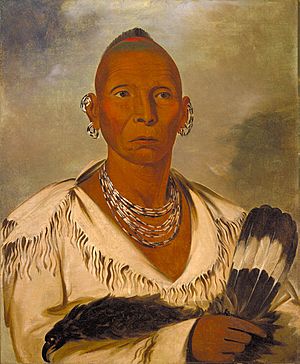
The Black Hawk War and Its Aftermath
More American settlers moved into Illinois and up the Mississippi River. This put pressure on the Sauk village. In several treaties, some Sauk leaders had signed agreements to sell the land where Saukenuk stood. Other parts of the tribe moved to new villages in Iowa and Missouri. These new places were closer to their winter hunting grounds.
The conflict in 1832, known as the Black Hawk War, ended with a victory for the U.S. Army and the state of Illinois. Many of Black Hawk's followers lost their lives. The area known as the Quad Cities was then fully opened for new settlers.
Even though the war was lost, many white Americans admired Black Hawk's bravery. They respected his efforts to defend his people's homeland. Because of this, Black Hawk became a folk hero.
In 1892, a statue of Black Hawk was placed at the site. Later, from 1934 to 1942, the Civilian Conservation Corps improved the park.
Saukenuk Today: A Look at the Historic Village Site
Today, the southern part of 11th Street in Rock Island (U.S. Route 67) covers where Saukenuk once was. The Black Hawk State Historic Site and the John Hauberg Museum of Native American Life are just east of this area. Saukenuk had close ties with a Meskwaki village to the north, which is now downtown Rock Island. Vandruff Island in the Rock River, south of the village, was also a place where villagers spent time. This island is now mostly a quarry, with some homes on its west side. Illinois Route 5 serves the historic site. This route connects with Interstate 74 in nearby Moline, Illinois.
John Hauberg Museum of Native American Life
The Hauberg Museum focuses on the culture of the Sauk and Meskwaki peoples. It displays many of their objects and tools. The museum building was built in 1934 by the Civilian Conservation Corps. It was named after John Hauberg, a kind person from Rock Island who supported the community.
Inside, you can see full-size models of Sauk winter and summer homes. There are also detailed scenes (dioramas) showing Native life from 1750 to 1830. You can find trade goods, jewelry, and household items. The museum also has several items that belonged to Black Hawk. These include his tomahawk, two of his clay tobacco pipes, and a bronze bust. This bust was made from a plaster mask of his face.
Singing Bird Nature Center
The Singing Bird Nature Center offers fun learning programs. It is located in the northwest part of the park. One section of the building is all about studying local native birds. The nature center is named after Black Hawk's wife, Asshewaqua. Her name means "Singing Bird."


